Exploring the Unique Neck Bone Structure of Giraffes
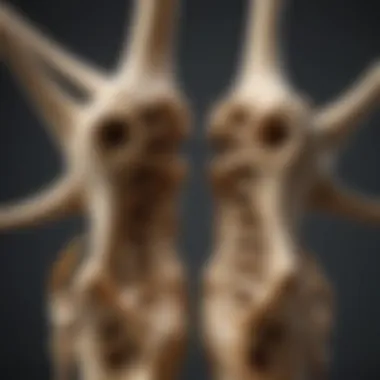
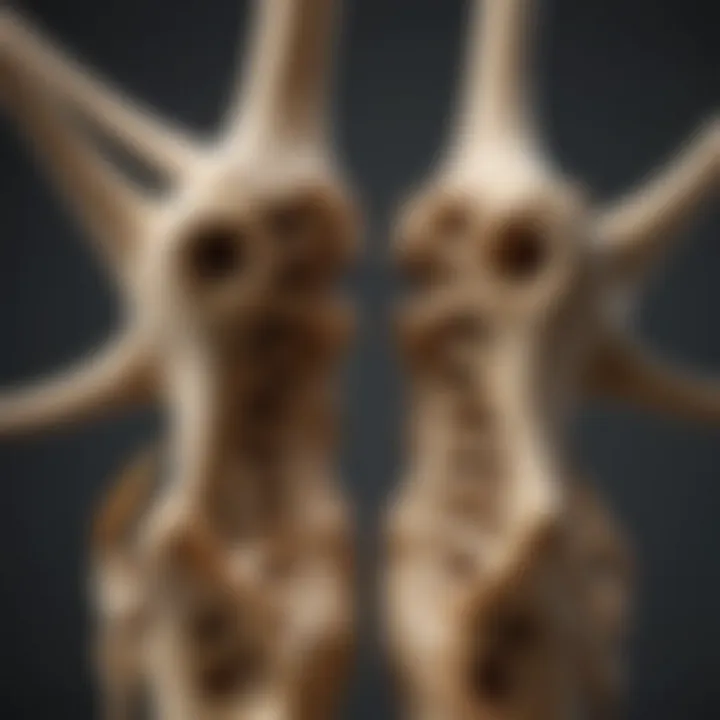
Intro
Giraffes stand as one of nature’s most recognizable creatures, renowned not only for their towering height but also for their distinctive neck structure. The giraffe’s neck is a marvel of evolution, distinguishing it from other mammals and enabling it to access food high in trees that other animals can’t reach. This article aims to dissect and analyze the components of the giraffe's neck bone structure, explaining the intricacies that make this animal unique.
The focus centers around the cervical vertebrae, which, despite being fewer in number than humans, are remarkably elongated. Understanding the anatomy behind the giraffe's neck offers insights into not just giraffes themselves, but broader principles of vertebrate anatomy and evolutionary adaptations. Through this exploration, we will uncover how the giraffe’s neck development aligns with ecological demands and the evolutionary paths that shaped its functionality.
As we dissect the anatomy surrounding this curious feature, we will also touch on biomechanics and implications for wildlife conservation. Each section of the article aims to weave together detailed descriptions with practical insights, catering to students, researchers, educators, and professionals interested in animal biology.
The adventure into this area of study promises not just to educate but also to spark a deeper appreciation for the evolutionary design of one of nature's tallest inhabitants.
Prologue to Giraffe Anatomy
Giraffes are a marvel of nature, both intriguing and fascinating in their anatomy. The focus here is on the tall and lanky neck that sets them apart from other mammals. Understanding the anatomy of a giraffe, especially its neck structure, is essential not only for zoologists but also for anyone interested in evolutionary biology and animal physiology. Through a closer look at their neck bones and how these support such an imposing stature, we uncover a treasure trove of information about the adaptations that have allowed giraffes to thrive in their natural habitats.
Defining the Giraffe
The giraffe, scientifically known as Giraffa camelopardalis, stands as the tallest land animal, reaching heights of up to 18 feet. Beyond height, they possess unique characteristics—long legs and a distinctively patterned coat that offers camouflage among the treetops. Their long necks, however, are what usually capture one's attention. These necks are not merely long; they are a complex structure made up of elongated cervical vertebrae. A giraffe has the same number of neck vertebrae as humans—seven—yet each of these vertebrae is much longer. This structure enables the giraffe to reach high foliage that other herbivores cannot access, giving it a unique feeding advantage.
Their anatomy reflects their ecological niche, and it is vital to appreciate how these traits allow giraffes to survive and flourish where they do.
Importance of Understanding Giraffe Physiology
Understanding the physiology of giraffes goes beyond mere curiosity; it provides insights into their survival strategies, reproductive behaviors, and even social structures. For example, the long necks facilitate unique feeding strategies, allowing adult giraffes to browse treetops. This feeding habit can significantly impact surrounding vegetation, which in turn affects the ecosystem.
Additionally, analyzing how their neck bones manage the biomechanical challenges posed by their towering height sheds light on evolutionary processes. Studying giraffes can aid in conservation efforts, helping to address challenges posed by habitat loss and climate change. Moreover, these insights contribute to a broader understanding of vertebrate evolution, revealing how adaptations occur in response to environmental pressures.
"To understand giraffes is to appreciate how living organisms adapt uniquely to their surroundings."
Such knowledge can spur further research, encouraging comparative studies with other species. This interspecies analysis can yield valuable data about evolution, biomechanics, and ecology, enriching our understanding of the natural world. In essence, the anatomy of a giraffe is a window into the processes that shape life on Earth.
The Skeletal System of Giraffes
The skeletal system of giraffes stands as one of the most remarkable adaptations in the animal kingdom. Understanding this system isn't just about counting bones or memorizing details; it highlights the intricate relationship between physical form and function that has evolved over millions of years. Giraffes, belonging to the family Giraffidae, carry unique skeletal traits that help them navigate their environments, optimize their physiology, and thrive in habitats where competition for resources is intense.
This article will examine how each constituent part of the giraffe's skeleton contributes to its overall identity. Notably, the giraffe's capacity to maintain stability while exhibiting considerable height presents a fascinating study of evolutionary engineering. Each bone plays a vital role in supporting not just their distinctive stature, but also their various behaviors, from foraging tactics to social interactions.
Key Components of the Giraffe Skeleton
At first glance, a giraffe's skeleton appears typical of a mammal but is peppered with specialized modifications. The core components include:
- Cervical Vertebrae: While most mammals have seven cervical vertebrae, the giraffe also sports just seven, but they are significantly elongated. This elongation is crucial for their towering necks, enabling the giraffe to reach higher foliage that many other herbivores cannot touch.
- Scapula and Clavicle: These bones offer stability while allowing a range of motion, pivotal for the giraffe as it stretches and balances itself while feeding. Their unique shape enhances their ability to maintain posture, even with a heavy head at the top of a long neck.
- Forelimbs: The giraffe's long legs aren't just for looks. They provide the necessary support structure to counterbalance the neck while allowing for substantial strides as it moves across the savannah.
- Skull Structure: The skull is adapted to house large ossicones, which are horn-like structures found on the tops of their heads. These play an integral role in social signaling and combat among males.
Each of these components interacts in a seamless manner, enabling the giraffe to balance weight effectively and minimize the risk of injury caused by sheer height.


Comparative Anatomy: Giraffes versus Other Mammals
When we stack the giraffe against other mammals, the contrasts become clear. Take the common horse, for instance. Despite both having long limbs, the horse's skeletal structure is designed for speed and ground-level foraging rather than the extensive vertical reach of the giraffe.
- Neck Modifications: Unlike horses, which bear a shorter neck with different functionalities, giraffe necks allow for a unique feeding niche, giving them access to nutrient-rich leaves. The giraffe's spine has adapted specifically to length; the vertebral structure is engineered for both strength and flexibility.
- Proportion and Balance: In terms of balance, giraffes rely on a unique distribution of weight through their legs and spine. Other mammals might possess more traditional body proportions; the giraffe's structure is almost a marvel of physics, with its limbs both supporting and complementing its upward reach.
- Evolutionary Divergence: It's also vital to consider how divergent evolutionary paths have molded these anatomical features. The giraffe's adaptations show how species can evolve distinct physical traits based on their ecological niches. Their long necks are not merely a gimmick; they come from generations refining an anatomical profile that serves practical purposes in their daily lives.
In summary, the skeletal system of the giraffe serves a multitude of functions. From reaching for the highest leaves to engaging in complex social behaviors, every element plays a role in their survival and ecological success. Understanding these systems provides insight into the marvels of evolution and the adaptive mechanisms that shape the lives of different species.
Giraffe Neck Structure
The neck of the giraffe is a fascinating anatomical marvel, worthy of examination beyond its mere length. This section shines a light on the unique structure of a giraffe's neck and discusses why it plays a pivotal role in the overall anatomy of the animal. The vertebral design not only allows for a striking height but also equips the giraffe to interact with its environment more effectively. When addressing giraffe anatomy, one cannot overlook the neck’s immense implications for behavior, feeding, and social interactions.
Configuration of Neck Bones
Giraffes possess a high degree of specialization in the configuration of their neck bones. They, like all mammals, have seven cervical vertebrae, but these bones are not just elongated; they are uniquely adapted to accommodate the giraffe’s towering stature. Each cervical vertebra is greatly stretched, providing an extensive range of motion along with the necessary strength to support the lengthy neck.
These vertebrae are larger than those of most other mammals, presenting a complex interlocking structure that contributes to stability while still allowing for movement. Interestingly, the joints between these vertebrae are notably flexible, enabling the giraffe to reach a wide range of vegetation. This adaptability is vital, as their main feeding strategy involves browsing high treetops for leaves.
Moreover, the presence of specialized ligaments adds to the neck’s support system, helping to distribute stress that arises from lifting or lowering their heads. Without this sophisticated design, the giraffe would face challenges in both feeding and movement—a fundamental point considering how they feed on acacia leaves, which are often hard to access.
Quantity of Cervical Vertebrae
The quantity of cervical vertebrae in giraffes reflects a fascinating aspect of adaptation in evolution. Like humans and most other mammals, giraffes have seven cervical vertebrae. However, the significant difference lies in the size and structure of these vertebrae. The sheer size and elongation mean that each vertebra is responsible for not just mere support, but also for the functional dynamics of their neck.
This maintains a balance between mobility and structural integrity. The elongated nature allows for a greater range of movement, while preserving the neck's strength. Each cervical vertebra plays a pivotal role in allowing giraffes to tilt, bend, and rotate their neck without compromising their balance.
Ultimately, the design serves evolutionary purposes well, playing into the challenge of finding food and navigating breeding behaviors.
The unique structure of giraffe necks demonstrates an important evolutionary adaptation, enabling these remarkable creatures to thrive in their environmental niche.
In summary, the anatomy of the giraffe's neck is not only an engineering feat but also a significant component of its survival strategy. By understanding the configuration and quantity of these bones, we gain richer insight into the niche this majestic animal occupies, redefining what it means to be built for success in the wild.
Understanding Cervical Vertebrae
Understanding the cervical vertebrae is crucial when exploring the anatomy of giraffes. These bones play a vital role, not only in supporting the animal's majestic height but also in allowing a range of movements that are essential for survival. They demonstrate how evolution has tweaked the design of neck bones for optimal function, showcasing a fascinating intersection of form and functionality. In this section, we will unpack the significance of cervical vertebrae, highlighting their roles and adaptations, and how these features benefit the giraffe in its natural habitat.
The Function of Cervical Vertebrae
The cervical vertebrae serve several important functions for giraffes. Predominantly, they provide the necessary structural support for the giraffe's elongated neck. Unlike other mammals, giraffes have a neck that can reach incredible heights. Each cervical vertebra within the neck not only bears weight but also facilitates a range of motions including bending and rotating.
Key Functions Include:
- Supporting the head: The cervical vertebrae’s structure is crucial for allowing the giraffe to maintain its large head high above the ground.
- Facilitating movement: The unique configuration enables giraffes to stretch and bend their necks to reach foliage high on trees, which is essential for feeding.
- Protecting the spinal cord: As these bones cradle the spinal cord, they help safeguard this crucial part of the nervous system, ensuring that the giraffe can respond swiftly to potential threats in the wild.
"The neck of a giraffe is a marvel of nature; it’s both an engineering wonder and a survival tool."
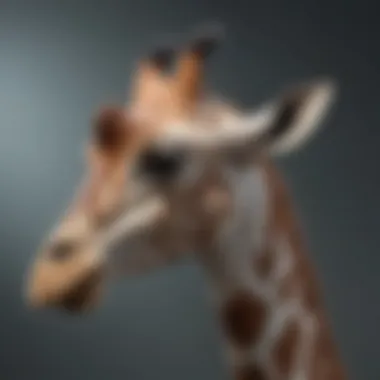
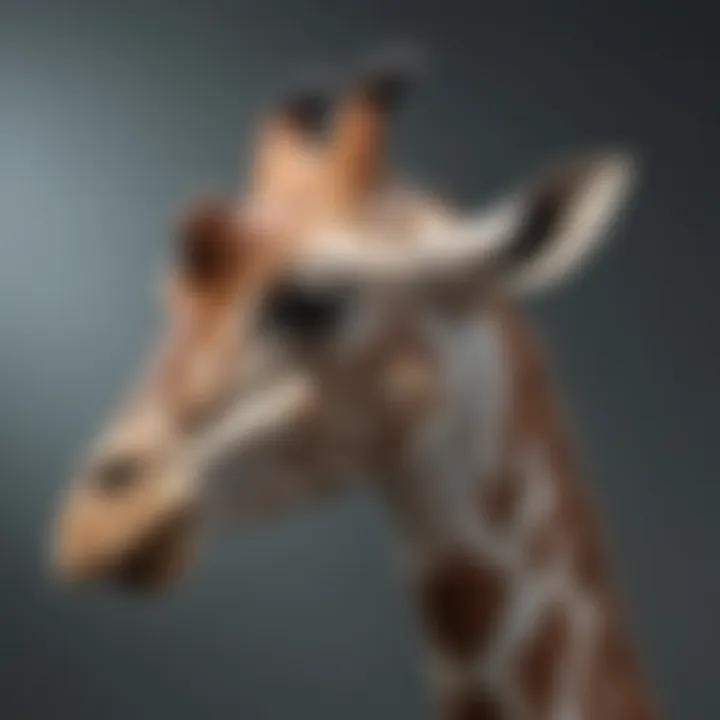
Adaptation for Height
The adaptation of cervical vertebrae to support height is perhaps one of the most striking aspects of giraffe anatomy. Each giraffe boasts an average of seven cervical vertebrae, which is the same number found in humans. However, these giraffes' vertebrae are significantly larger and elongated compared to those of more common mammals.
These adaptations allow giraffes to engage in behaviors that would otherwise be impossible. For instance:
- Feeding: With their long necks, giraffes can effortlessly graze on the leaves of tall trees, exploiting a food source that many other herbivores cannot reach.
- Vigilance: The elevation offers a wide vantage point, enhancing their ability to spot predators from a distance.
- Thermoregulation: The length of the neck can help in dissipating excess heat, as height allows for a more efficient exchange of warmth with the environment.
In essence, the cervical vertebrae of giraffes aren't just long; they're highly specialized structures that allow these remarkable animals to thrive in their unique ecological niches.
Biomechanical Perspective
The biomechanical aspect of giraffe anatomy is a cornerstone in understanding their extraordinary adaptations. This section sheds light on how these towering mammals manage stress and mobility, giving us insights into their unique neck structure and its significance. By grasping the mechanical principles at play, we can better recognize why giraffes have evolved this specific anatomy in the first place, with implications far beyond just their impressive height.
Stress Distribution in the Neck
The neck of a giraffe is a marvel not just for its length but also for how it distributes stress across its structure. A giraffe's neck can exert considerable forces during various activities, from feeding to social interactions. The cervical vertebrae, while fewer in number compared to what might be expected for such a long neck, are specially adapted to handle these stresses.
When a giraffe bends down to drink or reach for foliage, the weight of the head creates substantial torque. Here, the vertebrae work in unison to distribute this force evenly. The intervertebral discs act as shock absorbers, mitigating the impact on the bones and the surrounding musculature.
- Key Points in Stress Distribution:
- The cervical vertebrae are elongated and have a unique shape that decreases stress concentration.
- The arrangement of ligaments and muscles around the neck provides additional support during dynamic movements.
- Increases in neck length have led to adaptations in locomotion; thus giraffes often compensate for potential stress with specific postures.
In summary, the design of the giraffe's neck ensures that it remains functional despite the challenges posed by its impressive length. It provides a great example of how evolution fine-tunes anatomy for specific ecological niches.
Mobility versus Stability Trade-offs
While giraffes exhibit remarkable mobility in their necks, achieving this comes at a cost to stability. Ideally, any anatomical structure must balance flexibility and support—but for giraffes, the scales are tipped toward agility.
The interplay of mobility and stability reveals itself in various situations. For instance, with long necks adapted for reaching high foliage, giraffes are capable of intricate movements to navigate their environment. However, this is not without consequences.
- Trade-offs to Consider:
- Greater Flexibility: Their ability to stretch and fold their necks aids in foraging but also means they are prone to strains.
- Height and Center of Gravity: A higher center of gravity enhances reach but can lead to instability, particularly when they quickly change direction.
- Postural Adjustments: Giraffes often adjust their posture to maintain balance while remaining agile enough to thwart potential predators that may come from below.
In essence, these trade-offs affect how giraffes interact with their environment, shaping behaviors like feeding strategies and social dynamics. As they navigate the complexities of both mobility and stability, giraffes embody the remarkable feats of evolutionary design.
Evolutionary Considerations
The examination of giraffe neck anatomy offers a fascinating glimpse into how evolution shapes functionality. Understanding the evolutionary context of these animals helps illuminate the ways in which certain features have been selected for survival and adaptation over time. This section highlights two pivotal aspects: the theories behind the evolution of long necks and the broader implications such adaptations have on natural selection.
Theories on the Evolution of Long Necks
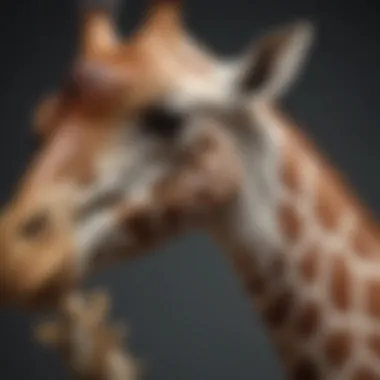
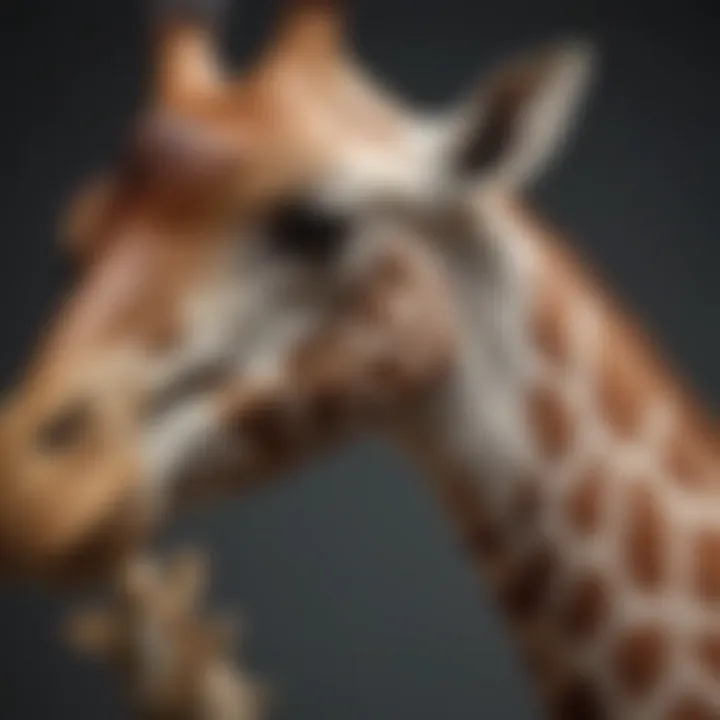
The evolution of the giraffe's long neck is a subject of rich and sometimes contentious debate. Various hypotheses exist that attempt to explain why giraffes evolved to have such elongated necks compared to their relatives, such as the okapi.
- Foraging Advantage Hypothesis: One prominent theory posits that long necks provide access to higher vegetation, allowing giraffes to feed on leaves and buds that other herbivores cannot reach. This would be particularly beneficial during dry seasons when lower foliage is scarce.
- Neck Wrestling Competition Hypothesis: Another angle suggests that long necks evolved as a result of male competition, where males engage in combat by swinging their necks and striking opponents. The winners of these battles gain privileges such as mating opportunities, pushing the selection for longer, stronger necks.
Studies supporting these ideas highlight the dual functionality of giraffe necks — they serve as tools for both feeding and combat. While both theories have merit, it is likely that the evolution of long necks results from a combination of these factors, along with other environmental pressures that favored giraffes with longer cervical vertebrae.
Implications for Natural Selection
The long neck of the giraffe is more than just a remarkable physical characteristic; it's a direct outcome of natural selection and adaptation. The implications extend beyond just feeding and mating, reflecting a broader picture of survival strategies in changing environments.
- Survival and Resource Utilization: Giraffes can exploit different ecological niches. By reaching higher foliage, they can avoid competition with ground-dwelling grazers during food shortages, thereby improving their chances of survival.
- Mating Success: Giraffe males can engage in necking or battling for dominance, allowing higher-ranking males to secure better reproductive opportunities. Traits that enhance combat abilities or access to resources get passed on, fuelling a cycle of survival and reproductive success.
- Behavioral Adaptations: Giraffes adapt their behavior based on their morphology. For instance, their unique neck structure allows them to maintain vigilance against predators while foraging. This behavioral adjustment also influences their social dynamics within herds.
"Nature selects for those traits that best meet environmental challenges, forming a delicate balance between survival and competition."
Delving into these evolutionary considerations opens avenues for further research, particularly in observing how contemporary environmental changes may impact giraffe populations and their adaptations in real-time.
Implications for Giraffe Behavior
Understanding how giraffes interact with their environment offers a window into their unique adaptations, particularly related to their impressive neck bone structure. The implications of this anatomy extend far beyond pure physicality; they influence vital aspects of both feeding strategies and social behavior. These behaviors are crucial for survival and flourishing within their habitats, making it essential to bridge the gap between anatomy and behavioral ecology.
Feeding Strategies and Neck Functionality
The giraffe's long neck is not merely a spectacle of evolutionary wonder; it holds critical advantages in foraging for food. The length of a giraffe’s neck allows it to reach high branches that many other herbivores can’t access. This becomes significant especially during dry seasons when lower vegetation is scarce. In fact, giraffes often favor leaves from acacia trees, which are often out of reach for other grazers.
Also, the neck’s versatility plays a huge part in feeding habits. Giraffes can adjust their necks for better positioning to exploit different heights within the canopy. Their ability to stretch and bend allows them to make the most of their feeding opportunities, essentially enabling a more varied diet, which is advantageous for sustenance. Without this remarkable neck musculature and bone structure, they would struggle to maintain an edge over their competition for food.
"A giraffe is like an investment banker—those who reach for the highest branches often get the best returns."
Moreover, the cervical vertebrae provide not just support but also the range of motion necessary for a giraffe to maneuver through dense foliage while feeding. This flexibility is essential, as it lets them nibble leaves efficiently without twisting their bodies in unnatural ways. Thus, the anatomy of the neck is a crucial player in the giraffe’s feeding strategy and, subsequently, its survival.
Social Dynamics Involving Neck Postures
Neck posture in giraffes also serves as a form of social signaling. Within herds, their necks are not only functional but also play a part in communication. The way giraffes position and move their necks can convey various messages to one another, ranging from aggression to courtship.
During fights, known as “necking,” males swing their necks and heads like battering rams, using their own neck strength to establish dominance and win mates. This behavior underscores the importance of neck structure in social hierarchies. Males with longer, stronger necks might have better prestige among peers and, thus, better breeding opportunities.
Conversely, in calmer moments, a lowered neck might signal submission or comfort. Observing these variations enhances our understanding of giraffe social dynamics and the innate connections that these majestic creatures forge with one another.
Closure and Future Research Directions
The study of the giraffe’s neck bone structure presents a fascinating glimpse into the realms of anatomy, evolution, and how form inspires function in the animal kingdom. This conclusion seeks to tie together insights from the earlier sections while also providing pathways for future research that could shed more light on these majestic creatures and their unique physiological traits.
Understanding the summary of key findings from our exploration is paramount. Giraffes possess an elaborate skeletal framework that defies traditional expectations in several respects. The cervical vertebrae, although fewer in number compared to humans, are uniquely adapted to support their towering frames. Apart from facilitating their remarkable height, these bones enable various functions, from feeding strategies that capitalize on their height to intricate social interactions displayed in neck postures during mating rituals or conflicts. Additionally, the biomechanical implications of their elongated necks underscore a fine balance between mobility and stability, enabling giraffes to maneuver their long necks with remarkable ease without sacrificing structural integrity.
In light of these revelations, there exists a pressing need for further investigation into several areas. Future studies might delve into:
- The role of genetics in the development of neck length and cervical vertebrae configuration. This could lead to a better understanding of how these traits are passed down and varied within different populations.
- The impact of environmental factors on neck development, particularly how habitat choices influence feeding strategies and social dynamics.
- Comparative studies with other long-necked mammals, such as the okapi, could provide insights into convergent evolutionary trends and adaptive necessities across species.
Moreover, rigorous examination of the biomechanical stresses incurred during various activities could lead to practical applications in fields as diverse as veterinary medicine and bioengineering. How the giraffe's neck structure withstands these forces without injury could inspire innovations in human design and architecture.
Overall, the ongoing research into giraffe neck anatomy will not only enhance scientific understanding but also contribute to broader discussions surrounding vertebrate evolution and adaptation. As we delve deeper, the lessons learned from these towering animals will resonate throughout multiple disciplines, offering a wealth of knowledge that continues to unfold.







